Harry Potter and the Half-Blood Prince
J. K. Rowling
The long-awaited, eagerly anticipated, arguably over-hyped Harry Potter and the Half-Blood Prince has arrived, and the question on the minds of kids, adults, fans, and skeptics alike is, "Is it worth the hype?" The answer, luckily, is simple: yep. A magnificent spectacle more than worth the price of admission, Harry Potter and the Half-Blood Prince will blow you away. However, given that so much has gone into protecting the secrets of the book (including armored trucks and injunctions), don't expect any spoilers in this review. It's much more fun not knowing what's coming—and in the case of Rowling's delicious sixth book, you don't want to know. Just sit tight, despite the earth-shattering revelations that will have your head in your hands as you hope the words will rearrange themselves into a different story. But take one warning to heart: do not open Harry Potter and the Half-Blood Prince until you have first found a secluded spot, safe from curious eyes, where you can tuck in for a good long read. Because once you start, you won't stop until you reach the very last page.
A darker book than any in the series thus far with a level of sophistication belying its genre, Harry Potter and the Half-Blood Prince moves the series into murkier waters and marks the arrival of Rowling onto the adult literary scene. While she has long been praised for her cleverness and wit, the strength of Book 6 lies in her subtle development of key characters, as well as her carefully nuanced depiction of a community at war. In Harry Potter and the Half-Blood Prince, no one and nothing is safe, including preconceived notions of good and evil and of right and wrong. With each book in her increasingly remarkable series, fans have nervously watched J.K. Rowling raise the stakes; gone are the simple delights of butterbeer and enchanted candy, and days when the worst ailment could be cured by a bite of chocolate. A series that began as a colorful lark full of magic and discovery has become a dark and deadly war zone. But this should not come as a shock to loyal readers. Rowling readied fans with Harry Potter and the Goblet of Fire and Harry Potter and the Order of the Phoenix by killing off popular characters and engaging the young students in battle. Still, there is an unexpected bleakness from the start of Book 6 that casts a mean shadow over Quidditch games, silly flirtations, and mountains of homework. Ready or not, the tremendous ending of Harry Potter and the Half-Blood Prince will leave stunned fans wondering what great and terrible events await in Book 7 if this sinister darkness is meant to light the way. —Daphne Durham
Visit the Harry Potter Store
Our Harry Potter Store features all things Harry, including books (box sets and collector's editions), audio CDs and cassettes, DVDs, soundtracks, games, and more.
Begin at the Beginning
Harry Potter and the Sorcerer's Stone
Hardcover
Paperback Harry Potter and the Chamber of Secrets
Hardcover
Paperback Harry Potter and the Prisoner of Azkaban
Hardcover
Paperback Harry Potter and the Goblet of Fire
Hardcover
Paperback Harry Potter and the Order of the Phoenix
Hardcover
Paperback
Why We Love Harry
Favorite Moments from the Series
There are plenty of reasons to love Rowling's wildly popular series—no doubt you have several dozen of your own. Our list features favorite moments, characters, and artifacts from the first five books. Keep in mind that this list is by no means exhaustive (what we love about Harry could fill ten books!) and does not include any of the spectacular revelatory moments that would spoil the books for those (few) who have not read them. Enjoy.
Harry Potter and the Sorcerer's Stone
* Harry's first trip to the zoo with the Dursleys, when a boa constrictor winks at him.
* When the Dursleys' house is suddenly besieged by letters for Harry from Hogwarts. Readers learn how much the Dursleys have been keeping from Harry. Rowling does a wonderful job in displaying the lengths to which Uncle Vernon will go to deny that magic exists.
* Harry's first visit to Diagon Alley with Hagrid. Full of curiosities and rich with magic and marvel, Harry's first trip includes a trip to Gringotts and Ollivanders, where Harry gets his wand (holly and phoenix feather) and discovers yet another connection to He-Who-Must-No-Be-Named. This moment is the reader's first full introduction to Rowling's world of witchcraft and wizards.
* Harry's experience with the Sorting Hat.
Harry Potter and the Chamber of Secrets
* The de-gnoming of the Weasleys' garden. Harry discovers that even wizards have chores—gnomes must be grabbed (ignoring angry protests "Gerroff me! Gerroff me!"), swung about (to make them too dizzy to come back), and tossed out of the garden—this delightful scene highlights Rowling's clever and witty genius.
* Harry's first experience with a Howler, sent to Ron by his mother.
* The Dueling Club battle between Harry and Malfoy. Gilderoy Lockhart starts the Dueling Club to help students practice spells on each other, but he is not prepared for the intensity of the animosity between Harry and Draco. Since they are still young, their minibattle is innocent enough, including tickling and dancing charms.
Harry Potter and the Prisoner of Azkaban
* Ron's attempt to use a telephone to call Harry at the Dursleys'.
* Harry's first encounter with a Dementor on the train (and just about any other encounter with Dementors). Harry's brush with the Dementors is terrifying and prepares Potter fans for a darker, scarier book.
* Harry, Ron, and Hermione's behavior in Professor Trelawney's Divination class. Some of the best moments in Rowling's books occur when she reminds us that the wizards-in-training at Hogwarts are, after all, just children. Clearly, even at a school of witchcraft and wizardry, classes can be boring and seem pointless to children.
* The Boggart lesson in Professor Lupin's classroom.
* Harry, Ron, and Hermione's knock-down confrontation with Snape.
Harry Potter and the Goblet of Fire
* Hermione's disgust at the reception for the veela (Bulgarian National Team Mascots) at the Quidditch World Cup. Rowling's fourth book addresses issues about growing up—the dynamic between the boys and girls at Hogwarts starts to change. Nowhere is this more plain than the hilarious scene in which magical cheerleaders nearly convince Harry and Ron to jump from the stands to impress them.
* Viktor Krum's crush on Hermione—and Ron's objection to it.
* Malfoy's "Potter Stinks" badge.
* Hermione's creation of S.P.E.W., the intolerant bigotry of the Death Eaters, and the danger of the Triwizard Tournament. Add in the changing dynamics between girls and boys at Hogwarts, and suddenly Rowling's fourth book has a weight and seriousness not as present in early books in the series. Candy and tickle spells are left behind as the students tackle darker, more serious issues and take on larger responsibilities, including the knowledge of illegal curses.
Harry Potter and the Order of the Phoenix
* Harry's outburst to his friends at No. 12 Grimmauld Place. A combination of frustration over being kept in the dark and fear that he will be expelled fuels much of Harry's anger, and it all comes out at once, directly aimed at Ron and Hermione. Rowling perfectly portrays Harry's frustration at being too old to shirk responsibility, but too young to be accepted as part of the fight that he knows is coming.
* Harry's detention with Professor Umbridge. Rowling shows her darker side, leading readers to believe that Hogwarts is no longer a safe haven for young wizards. Dolores represents a bureaucratic tyrant capable of real evil, and Harry is forced to endure their private battle of wills alone.
* Harry and Cho's painfully awkward interactions. Rowling clearly remembers what it was like to be a teenager.
* Harry's Occlumency lessons with Snape.
* Dumbledore's confession to Harry.
Magic, Mystery, and Mayhem: A Conversation with J.K. Rowling
"I am an extraordinarily lucky person, doing what I love best in the world. I'm sure that I will always be a writer. It was wonderful enough just to be published. The greatest reward is the enthusiasm of the readers." —J.K. Rowling
Find out more about Harry's creator in our exclusive interview with J.K. Rowling.
Did You Know? The Little White Horse was J.K. Rowling's favorite book as a child. </ a> Jane Austen is Rowling's favorite author. Roddy Doyle is Rowling's favorite living writer.
A Few Words from Mary GrandPré
"When I illustrate a cover or a book, I draw upon what the author tells me; that's how I see my responsibility as an illustrator. J.K. Rowling is very descriptive in her writing—she gives an illustrator a lot to work with. Each story is packed full of rich visual descriptions of the atmosphere, the mood, the setting, and all the different creatures and people. She makes it easy for me. The images just develop as I sketch and retrace until it feels right and matches her vision." Check out more Harry Potter art from illustrator Mary GrandPré.
0439784549
Harry Potter and the Order of the Phoenix
J. K. Rowling
As his fifth year at Hogwarts School of Witchcraft and Wizardry approaches, 15-year-old Harry Potter is in full-blown adolescence, complete with regular outbursts of rage, a nearly debilitating crush, and the blooming of a powerful sense of rebellion. It's been yet another infuriating and boring summer with the despicable Dursleys, this time with minimal contact from our hero's non-Muggle friends from school. Harry is feeling especially edgy at the lack of news from the magic world, wondering when the freshly revived evil Lord Voldemort will strike. Returning to Hogwarts will be a relief... or will it?
The fifth book in J.K. Rowling's Harry Potter series follows the darkest year yet for our young wizard, who finds himself knocked down a peg or three after the events of last year. Somehow, over the summer, gossip (usually traced back to the magic world's newspaper, the Daily Prophet) has turned Harry's tragic and heroic encounter with Voldemort at the Triwizard Tournament into an excuse to ridicule and discount the teen. Even Professor Dumbledore, headmaster of the school, has come under scrutiny by the Ministry of Magic, which refuses to officially acknowledge the terrifying truth that Voldemort is back. Enter a particularly loathsome new character: the toadlike and simpering ("hem, hem") Dolores Umbridge, senior undersecretary to the Minister of Magic, who takes over the vacant position of Defense Against Dark Arts teacher—and in no time manages to become the High Inquisitor of Hogwarts, as well. Life isn't getting any easier for Harry Potter. With an overwhelming course load as the fifth years prepare for their Ordinary Wizarding Levels examinations (O.W.Ls), devastating changes in the Gryffindor Quidditch team lineup, vivid dreams about long hallways and closed doors, and increasing pain in his lightning-shaped scar, Harry's resilience is sorely tested.
Harry Potter and the Order of the Phoenix, more than any of the four previous novels in the series, is a coming-of-age story. Harry faces the thorny transition into adulthood, when adult heroes are revealed to be fallible, and matters that seemed black-and-white suddenly come out in shades of gray. Gone is the wide-eyed innocent, the whiz kid of Sorcerer's Stone. Here we have an adolescent who's sometimes sullen, often confused (especially about girls), and always self-questioning. Confronting death again, as well as a startling prophecy, Harry ends his year at Hogwarts exhausted and pensive. Readers, on the other hand, will be energized as they enter yet again the long waiting period for the next title in the marvelous, magical series. (Ages 9 and older) —Emilie Coulter
043935806X
Harry Potter and the Order of the Phoenix
J. K. Rowling, Mary GrandPré
This cloth-covered deluxe edition features full-color printed endpapers and a foil-stamped title on the spine, and comes complete with a full-color slipcase with matte lamination and foil-stamping. Best of all, the removable, suitable-for-framing book jacket is emblazoned with exclusive, original artwork (that's different than the regular edition) by illustrator Mary GrandPré—a one-of-a-kind keepsake that you won't find anywhere else.
0439567629
Harry Potter and the Chamber of Secrets
J.K. Rowling
What makes the Harry Potter series so successful? Maybe it's the fact that J.K. Rowling doesn't write children's books, she writes children's stories, more in the tradition of the Brothers Grimm than Dr. Seuss. The exploits of Harry and his friends captivate even the shortest attention spans by engaging the imagination with vivid characters and fast-moving action, instead of trying to merely catch the eye with colorful pictures or pop-up effects. Not surprisingly, the Potter tales sound wonderful read aloud, and adapt to the audiobook format extremely well. Broadway actor Jim Dale's impressive vocal range gives each character in the book its own distinctive voice—a considerable task, given the pantheon of witches, warlocks, ghosts, ghouls, dwarves, and elves that Harry encounters in his second outing. And thankfully, since the book is read unabridged, no one's favorite character is omitted. Engaging for children without being childish, the audio version of Harry Potter and the Chamber of Secrets is worthy addition to the deservedly popular series. (Running time: 9 hours, 7 CDs) —Andrew Nieland
0807281948
Harry Potter and the Goblet of Fire
J.K. Rowling
In Harry Potter and the Goblet of Fire, J.K. Rowling offers up equal parts danger and delight—and any number of dragons, house-elves, and death-defying challenges. Now 14, her orphan hero has only two more weeks with his Muggle relatives before returning to Hogwarts School of Witchcraft and Wizardry. Yet one night a vision harrowing enough to make his lightning-bolt-shaped scar burn has Harry on edge and contacting his godfather-in-hiding, Sirius Black. Happily, the prospect of attending the season's premier sporting event, the Quidditch World Cup, is enough to make Harry momentarily forget that Lord Voldemort and his sinister familiars—the Death Eaters—are out for murder.
Readers, we will cast a giant invisibility cloak over any more plot and reveal only that You-Know-Who is very much after Harry and that this year there will be no Quidditch matches between Gryffindor, Ravenclaw, Hufflepuff, and Slytherin. Instead, Hogwarts will vie with two other magicians' schools, the stylish Beauxbatons and the icy Durmstrang, in a Triwizard Tournament. Those chosen to compete will undergo three supreme tests. Could Harry be one of the lucky contenders?
But Quidditch buffs need not go into mourning: we get our share of this great game at the World Cup. Attempting to go incognito as Muggles, 100,000 witches and wizards converge on a "nice deserted moor." As ever, Rowling magicks up the details that make her world so vivid, and so comic. Several spectators' tents, for instance, are entirely unquotidian. One is a minipalace, complete with live peacocks; another has three floors and multiple turrets. And the sports paraphernalia on offer includes rosettes "squealing the names of the players" as well as "tiny models of Firebolts that really flew, and collectible figures of famous players, which strolled across the palm of your hand, preening themselves." Needless to say, the two teams are decidedly different, down to their mascots. Bulgaria is supported by the beautiful veela, who instantly enchant everyone—including Ireland's supporters—over to their side. Until, that is, thousands of tiny cheerleaders engage in some pyrotechnics of their own: "The leprechauns had risen into the air again, and this time, they formed a giant hand, which was making a very rude sign indeed at the veela across the field."
Long before her fourth installment appeared, Rowling warned that it would be darker, and it's true that every exhilaration is equaled by a moment that has us fearing for Harry's life, the book's emotions running as deep as its dangers. Along the way, though, she conjures up such new characters as Alastor "Mad-Eye" Moody, a Dark Wizard catcher who may or may not be getting paranoid in his old age, and Rita Skeeter, who beetles around Hogwarts in search of stories. (This Daily Prophet scoop artist has a Quick-Quotes Quill that turns even the most innocent assertion into tabloid innuendo.) And at her bedazzling close, Rowling leaves several plot strands open, awaiting book 5. This fan is ready to wager that the author herself is part veela—her pen her wand, her commitment to her world complete. (Ages 9 and older) —Kerry Fried
0807282596
Harry Potter and the Goblet of Fire
J.K. Rowling
In Harry Potter and the Goblet of Fire, J.K. Rowling offers up equal parts danger and delight—and any number of dragons, house-elves, and death-defying challenges. Now 14, her orphan hero has only two more weeks with his Muggle relatives before returning to Hogwarts School of Witchcraft and Wizardry. Yet one night a vision harrowing enough to make his lightning-bolt-shaped scar burn has Harry on edge and contacting his godfather-in-hiding, Sirius Black. Happily, the prospect of attending the season's premier sporting event, the Quidditch World Cup, is enough to make Harry momentarily forget that Lord Voldemort and his sinister familiars—the Death Eaters—are out for murder.
Readers, we will cast a giant invisibility cloak over any more plot and reveal only that You-Know-Who is very much after Harry and that this year there will be no Quidditch matches between Gryffindor, Ravenclaw, Hufflepuff, and Slytherin. Instead, Hogwarts will vie with two other magicians' schools, the stylish Beauxbatons and the icy Durmstrang, in a Triwizard Tournament. Those chosen to compete will undergo three supreme tests. Could Harry be one of the lucky contenders?
But Quidditch buffs need not go into mourning: we get our share of this great game at the World Cup. Attempting to go incognito as Muggles, 100,000 witches and wizards converge on a "nice deserted moor." As ever, Rowling magicks up the details that make her world so vivid, and so comic. Several spectators' tents, for instance, are entirely unquotidian. One is a minipalace, complete with live peacocks; another has three floors and multiple turrets. And the sports paraphernalia on offer includes rosettes "squealing the names of the players" as well as "tiny models of Firebolts that really flew, and collectible figures of famous players, which strolled across the palm of your hand, preening themselves." Needless to say, the two teams are decidedly different, down to their mascots. Bulgaria is supported by the beautiful veela, who instantly enchant everyone—including Ireland's supporters—over to their side. Until, that is, thousands of tiny cheerleaders engage in some pyrotechnics of their own: "The leprechauns had risen into the air again, and this time, they formed a giant hand, which was making a very rude sign indeed at the veela across the field."
Long before her fourth installment appeared, Rowling warned that it would be darker, and it's true that every exhilaration is equaled by a moment that has us fearing for Harry's life, the book's emotions running as deep as its dangers. Along the way, though, she conjures up such new characters as Alastor "Mad-Eye" Moody, a Dark Wizard catcher who may or may not be getting paranoid in his old age, and Rita Skeeter, who beetles around Hogwarts in search of stories. (This Daily Prophet scoop artist has a Quick-Quotes Quill that turns even the most innocent assertion into tabloid innuendo.) And at her bedazzling close, Rowling leaves several plot strands open, awaiting book 5. This fan is ready to wager that the author herself is part veela—her pen her wand, her commitment to her world complete. (Ages 9 and older) —Kerry Fried
0439139597
|
Harry Potter and the Half-Blood Prince
J.K. Rowling
The long-awaited, eagerly anticipated, arguably over-hyped Harry Potter and the Half-Blood Prince has arrived, and the question on the minds of kids, adults, fans, and skeptics alike is, "Is it worth the hype?" The answer, luckily, is simple: yep. A magnificent spectacle more than worth the price of admission, Harry Potter and the Half-Blood Prince will blow you away. However, given that so much has gone into protecting the secrets of the book (including armored trucks and injunctions), don't expect any spoilers in this review. It's much more fun not knowing what's coming—and in the case of Rowling's delicious sixth book, you don't want to know. Just sit tight, despite the earth-shattering revelations that will have your head in your hands as you hope the words will rearrange themselves into a different story. But take one warning to heart: do not open Harry Potter and the Half-Blood Prince until you have first found a secluded spot, safe from curious eyes, where you can tuck in for a good long read. Because once you start, you won't stop until you reach the very last page.
A darker book than any in the series thus far with a level of sophistication belying its genre, Harry Potter and the Half-Blood Prince moves the series into murkier waters and marks the arrival of Rowling onto the adult literary scene. While she has long been praised for her cleverness and wit, the strength of Book 6 lies in her subtle development of key characters, as well as her carefully nuanced depiction of a community at war. In Harry Potter and the Half-Blood Prince, no one and nothing is safe, including preconceived notions of good and evil and of right and wrong. With each book in her increasingly remarkable series, fans have nervously watched J.K. Rowling raise the stakes; gone are the simple delights of butterbeer and enchanted candy, and days when the worst ailment could be cured by a bite of chocolate. A series that began as a colorful lark full of magic and discovery has become a dark and deadly war zone. But this should not come as a shock to loyal readers. Rowling readied fans with Harry Potter and the Goblet of Fire and Harry Potter and the Order of the Phoenix by killing off popular characters and engaging the young students in battle. Still, there is an unexpected bleakness from the start of Book 6 that casts a mean shadow over Quidditch games, silly flirtations, and mountains of homework. Ready or not, the tremendous ending of Harry Potter and the Half-Blood Prince will leave stunned fans wondering what great and terrible events await in Book 7 if this sinister darkness is meant to light the way. —Daphne Durham
Visit the Harry Potter Store
Our Harry Potter Store features all things Harry, including books (box sets and collector's editions), audio CDs and cassettes, DVDs, soundtracks, games, and more.
Begin at the Beginning
Harry Potter and the Sorcerer's Stone
Hardcover
Paperback Harry Potter and the Chamber of Secrets
Hardcover
Paperback Harry Potter and the Prisoner of Azkaban
Hardcover
Paperback Harry Potter and the Goblet of Fire
Hardcover
Paperback Harry Potter and the Order of the Phoenix
Hardcover
Paperback
Why We Love Harry
Favorite Moments from the Series
There are plenty of reasons to love Rowling's wildly popular series—no doubt you have several dozen of your own. Our list features favorite moments, characters, and artifacts from the first five books. Keep in mind that this list is by no means exhaustive (what we love about Harry could fill ten books!) and does not include any of the spectacular revelatory moments that would spoil the books for those (few) who have not read them. Enjoy.
Harry Potter and the Sorcerer's Stone
* Harry's first trip to the zoo with the Dursleys, when a boa constrictor winks at him.
* When the Dursleys' house is suddenly besieged by letters for Harry from Hogwarts. Readers learn how much the Dursleys have been keeping from Harry. Rowling does a wonderful job in displaying the lengths to which Uncle Vernon will go to deny that magic exists.
* Harry's first visit to Diagon Alley with Hagrid. Full of curiosities and rich with magic and marvel, Harry's first trip includes a trip to Gringotts and Ollivanders, where Harry gets his wand (holly and phoenix feather) and discovers yet another connection to He-Who-Must-No-Be-Named. This moment is the reader's first full introduction to Rowling's world of witchcraft and wizards.
* Harry's experience with the Sorting Hat.
Harry Potter and the Chamber of Secrets
* The de-gnoming of the Weasleys' garden. Harry discovers that even wizards have chores—gnomes must be grabbed (ignoring angry protests "Gerroff me! Gerroff me!"), swung about (to make them too dizzy to come back), and tossed out of the garden—this delightful scene highlights Rowling's clever and witty genius.
* Harry's first experience with a Howler, sent to Ron by his mother.
* The Dueling Club battle between Harry and Malfoy. Gilderoy Lockhart starts the Dueling Club to help students practice spells on each other, but he is not prepared for the intensity of the animosity between Harry and Draco. Since they are still young, their minibattle is innocent enough, including tickling and dancing charms.
Harry Potter and the Prisoner of Azkaban
* Ron's attempt to use a telephone to call Harry at the Dursleys'.
* Harry's first encounter with a Dementor on the train (and just about any other encounter with Dementors). Harry's brush with the Dementors is terrifying and prepares Potter fans for a darker, scarier book.
* Harry, Ron, and Hermione's behavior in Professor Trelawney's Divination class. Some of the best moments in Rowling's books occur when she reminds us that the wizards-in-training at Hogwarts are, after all, just children. Clearly, even at a school of witchcraft and wizardry, classes can be boring and seem pointless to children.
* The Boggart lesson in Professor Lupin's classroom.
* Harry, Ron, and Hermione's knock-down confrontation with Snape.
Harry Potter and the Goblet of Fire
* Hermione's disgust at the reception for the veela (Bulgarian National Team Mascots) at the Quidditch World Cup. Rowling's fourth book addresses issues about growing up—the dynamic between the boys and girls at Hogwarts starts to change. Nowhere is this more plain than the hilarious scene in which magical cheerleaders nearly convince Harry and Ron to jump from the stands to impress them.
* Viktor Krum's crush on Hermione—and Ron's objection to it.
* Malfoy's "Potter Stinks" badge.
* Hermione's creation of S.P.E.W., the intolerant bigotry of the Death Eaters, and the danger of the Triwizard Tournament. Add in the changing dynamics between girls and boys at Hogwarts, and suddenly Rowling's fourth book has a weight and seriousness not as present in early books in the series. Candy and tickle spells are left behind as the students tackle darker, more serious issues and take on larger responsibilities, including the knowledge of illegal curses.
Harry Potter and the Order of the Phoenix
* Harry's outburst to his friends at No. 12 Grimmauld Place. A combination of frustration over being kept in the dark and fear that he will be expelled fuels much of Harry's anger, and it all comes out at once, directly aimed at Ron and Hermione. Rowling perfectly portrays Harry's frustration at being too old to shirk responsibility, but too young to be accepted as part of the fight that he knows is coming.
* Harry's detention with Professor Umbridge. Rowling shows her darker side, leading readers to believe that Hogwarts is no longer a safe haven for young wizards. Dolores represents a bureaucratic tyrant capable of real evil, and Harry is forced to endure their private battle of wills alone.
* Harry and Cho's painfully awkward interactions. Rowling clearly remembers what it was like to be a teenager.
* Harry's Occlumency lessons with Snape.
* Dumbledore's confession to Harry.
Magic, Mystery, and Mayhem: A Conversation with J.K. Rowling
"I am an extraordinarily lucky person, doing what I love best in the world. I'm sure that I will always be a writer. It was wonderful enough just to be published. The greatest reward is the enthusiasm of the readers." —J.K. Rowling
Find out more about Harry's creator in our exclusive interview with J.K. Rowling.
Did You Know? The Little White Horse was J.K. Rowling's favorite book as a child. </ a> Jane Austen is Rowling's favorite author. Roddy Doyle is Rowling's favorite living writer.
A Few Words from Mary GrandPré
"When I illustrate a cover or a book, I draw upon what the author tells me; that's how I see my responsibility as an illustrator. J.K. Rowling is very descriptive in her writing—she gives an illustrator a lot to work with. Each story is packed full of rich visual descriptions of the atmosphere, the mood, the setting, and all the different creatures and people. She makes it easy for me. The images just develop as I sketch and retrace until it feels right and matches her vision." Check out more Harry Potter art from illustrator Mary GrandPré.
0307283658
Harry Potter and the Order of the Phoenix
J.K. Rowling
As his fifth year at Hogwarts School of Witchcraft and Wizardry approaches, 15-year-old Harry Potter is in full-blown adolescence, complete with regular outbursts of rage, a nearly debilitating crush, and the blooming of a powerful sense of rebellion. It's been yet another infuriating and boring summer with the despicable Dursleys, this time with minimal contact from our hero's non-Muggle friends from school. Harry is feeling especially edgy at the lack of news from the magic world, wondering when the freshly revived evil Lord Voldemort will strike. Returning to Hogwarts will be a relief... or will it?
The fifth book in J.K. Rowling's Harry Potter series follows the darkest year yet for our young wizard, who finds himself knocked down a peg or three after the events of last year. Somehow, over the summer, gossip (usually traced back to the magic world's newspaper, the Daily Prophet) has turned Harry's tragic and heroic encounter with Voldemort at the Triwizard Tournament into an excuse to ridicule and discount the teen. Even Professor Dumbledore, headmaster of the school, has come under scrutiny by the Ministry of Magic, which refuses to officially acknowledge the terrifying truth that Voldemort is back. Enter a particularly loathsome new character: the toadlike and simpering ("hem, hem") Dolores Umbridge, senior undersecretary to the Minister of Magic, who takes over the vacant position of Defense Against Dark Arts teacher—and in no time manages to become the High Inquisitor of Hogwarts, as well. Life isn't getting any easier for Harry Potter. With an overwhelming course load as the fifth years prepare for their Ordinary Wizarding Levels examinations (O.W.Ls), devastating changes in the Gryffindor Quidditch team lineup, vivid dreams about long hallways and closed doors, and increasing pain in his lightning-shaped scar, Harry's resilience is sorely tested.
Harry Potter and the Order of the Phoenix, more than any of the four previous novels in the series, is a coming-of-age story. Harry faces the thorny transition into adulthood, when adult heroes are revealed to be fallible, and matters that seemed black-and-white suddenly come out in shades of gray. Gone is the wide-eyed innocent, the whiz kid of Sorcerer's Stone. Here we have an adolescent who's sometimes sullen, often confused (especially about girls), and always self-questioning. Confronting death again, as well as a startling prophecy, Harry ends his year at Hogwarts exhausted and pensive. Readers, on the other hand, will be energized as they enter yet again the long waiting period for the next title in the marvelous, magical series. (Ages 9 and older) —Emilie Coulter
0807220299
Harry Potter and the Prisoner of Azkaban
J.K. Rowling
For most children, summer vacation is something to look forward to. But not for our 13-year-old hero, who's forced to spend his summers with an aunt, uncle, and cousin who detest him. The third book in J.K. Rowling's Harry Potter series catapults into action when the young wizard "accidentally" causes the Dursleys' dreadful visitor Aunt Marge to inflate like a monstrous balloon and drift up to the ceiling. Fearing punishment from Aunt Petunia and Uncle Vernon (and from officials at Hogwarts School of Witchcraft and Wizardry who strictly forbid students to cast spells in the nonmagic world of Muggles), Harry lunges out into the darkness with his heavy trunk and his owl Hedwig.
As it turns out, Harry isn't punished at all for his errant wizardry. Instead he is mysteriously rescued from his Muggle neighborhood and whisked off in a triple-decker, violently purple bus to spend the remaining weeks of summer in a friendly inn called the Leaky Cauldron. What Harry has to face as he begins his third year at Hogwarts explains why the officials let him off easily. It seems that Sirius Black—an escaped convict from the prison of Azkaban—is on the loose. Not only that, but he's after Harry Potter. But why? And why do the Dementors, the guards hired to protect him, chill Harry's very heart when others are unaffected? Once again, Rowling has created a mystery that will have children and adults cheering, not to mention standing in line for her next book. Fortunately, there are four more in the works. (Ages 9 and older) —Karin Snelson
0807282324
Harry Potter and the Sorcerer's Stone
J.K. Rowling
Say you've spent the first 10 years of your life sleeping under the stairs of a family who loathes you. Then, in an absurd, magical twist of fate you find yourself surrounded by wizards, a caged snowy owl, a phoenix-feather wand, and jellybeans that come in every flavor, including strawberry, curry, grass, and sardine. Not only that, but you discover that you are a wizard yourself! This is exactly what happens to young Harry Potter in J.K. Rowling's enchanting, funny debut novel, Harry Potter and the Sorcerer's Stone. In the nonmagic human world—the world of "Muggles"—Harry is a nobody, treated like dirt by the aunt and uncle who begrudgingly inherited him when his parents were killed by the evil Voldemort. But in the world of wizards, small, skinny Harry is famous as a survivor of the wizard who tried to kill him. He is left only with a lightning-bolt scar on his forehead, curiously refined sensibilities, and a host of mysterious powers to remind him that he's quite, yes, altogether different from his aunt, uncle, and spoiled, piglike cousin Dudley.
A mysterious letter, delivered by the friendly giant Hagrid, wrenches Harry from his dreary, Muggle-ridden existence: "We are pleased to inform you that you have been accepted at Hogwarts School of Witchcraft and Wizardry." Of course, Uncle Vernon yells most unpleasantly, "I AM NOT PAYING FOR SOME CRACKPOT OLD FOOL TO TEACH HIM MAGIC TRICKS!" Soon enough, however, Harry finds himself at Hogwarts with his owl Hedwig... and that's where the real adventure—humorous, haunting, and suspenseful—begins. Harry Potter and the Sorcerer's Stone, first published in England as Harry Potter and the Philosopher's Stone, continues to win major awards in England. So far it has won the National Book Award, the Smarties Prize, the Children's Book Award, and is short-listed for the Carnegie Medal, the U.K. version of the Newbery Medal. This magical, gripping, brilliant book—a future classic to be sure—will leave kids clamoring for Harry Potter and the Chamber of Secrets and Harry Potter and the Prisoner of Azkaban. (Ages 8 to 13) —Karin Snelson
0590353403
Harry Potter and the Sorcerer's Stone
J.K. Rowling
Say you've spent the first 10 years of your life sleeping under the stairs of a family who loathes you. Then, in an absurd, magical twist of fate you find yourself surrounded by wizards, a caged snowy owl, a phoenix-feather wand, and jellybeans that come in every flavor, including strawberry, curry, grass, and sardine. Not only that, but you discover that you are a wizard yourself! This is exactly what happens to young Harry Potter in J.K. Rowling's enchanting, funny debut novel, Harry Potter and the Sorcerer's Stone. In the nonmagic human world—the world of "Muggles"—Harry is a nobody, treated like dirt by the aunt and uncle who begrudgingly inherited him when his parents were killed by the evil Voldemort. But in the world of wizards, small, skinny Harry is famous as a survivor of the wizard who tried to kill him. He is left only with a lightning-bolt scar on his forehead, curiously refined sensibilities, and a host of mysterious powers to remind him that he's quite, yes, altogether different from his aunt, uncle, and spoiled, piglike cousin Dudley.
A mysterious letter, delivered by the friendly giant Hagrid, wrenches Harry from his dreary, Muggle-ridden existence: "We are pleased to inform you that you have been accepted at Hogwarts School of Witchcraft and Wizardry." Of course, Uncle Vernon yells most unpleasantly, "I AM NOT PAYING FOR SOME CRACKPOT OLD FOOL TO TEACH HIM MAGIC TRICKS!" Soon enough, however, Harry finds himself at Hogwarts with his owl Hedwig... and that's where the real adventure—humorous, haunting, and suspenseful—begins. Harry Potter and the Sorcerer's Stone, first published in England as Harry Potter and the Philosopher's Stone, continues to win major awards in England. So far it has won the National Book Award, the Smarties Prize, the Children's Book Award, and is short-listed for the Carnegie Medal, the U.K. version of the Newbery Medal. This magical, gripping, brilliant book—a future classic to be sure—will leave kids clamoring for Harry Potter and the Chamber of Secrets and Harry Potter and the Prisoner of Azkaban. (Ages 8 to 13) —Karin Snelson
0807281956
Harry Potter and the Prisoner of Azkaban
J.K. Rowling, Mary GrandPré
For most children, summer vacation is something to look forward to. But not for our 13-year-old hero, who's forced to spend his summers with an aunt, uncle, and cousin who detest him. The third book in J.K. Rowling's Harry Potter series catapults into action when the young wizard "accidentally" causes the Dursleys' dreadful visitor Aunt Marge to inflate like a monstrous balloon and drift up to the ceiling. Fearing punishment from Aunt Petunia and Uncle Vernon (and from officials at Hogwarts School of Witchcraft and Wizardry who strictly forbid students to cast spells in the nonmagic world of Muggles), Harry lunges out into the darkness with his heavy trunk and his owl Hedwig.
As it turns out, Harry isn't punished at all for his errant wizardry. Instead he is mysteriously rescued from his Muggle neighborhood and whisked off in a triple-decker, violently purple bus to spend the remaining weeks of summer in a friendly inn called the Leaky Cauldron. What Harry has to face as he begins his third year at Hogwarts explains why the officials let him off easily. It seems that Sirius Black—an escaped convict from the prison of Azkaban—is on the loose. Not only that, but he's after Harry Potter. But why? And why do the Dementors, the guards hired to protect him, chill Harry's very heart when others are unaffected? Once again, Rowling has created a mystery that will have children and adults cheering, not to mention standing in line for her next book. Fortunately, there are four more in the works. (Ages 9 and older) —Karin Snelson
0439136350
|
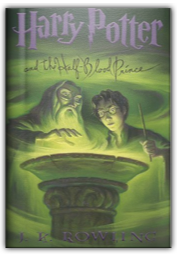
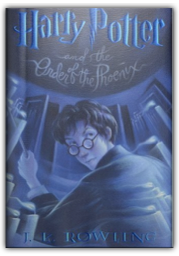
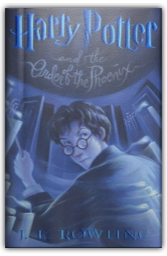
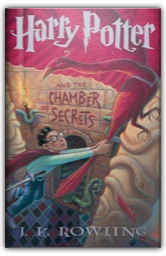
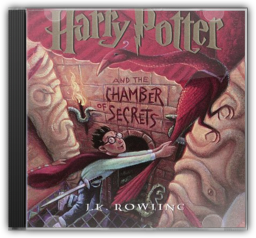
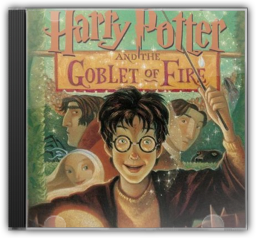
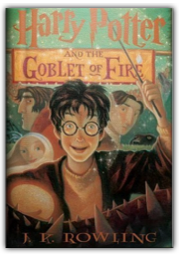
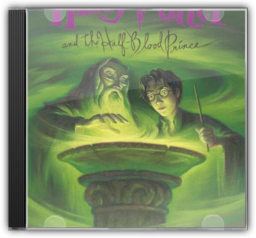
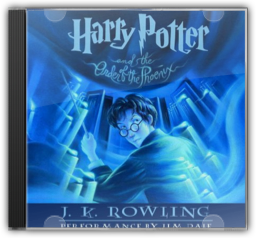
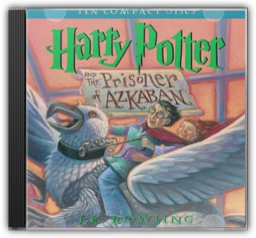
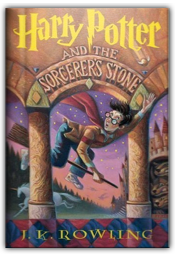
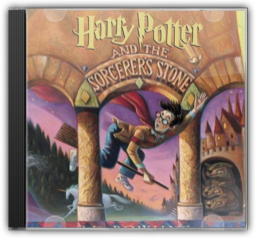
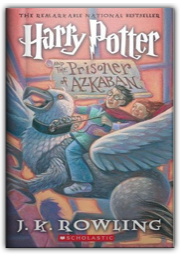


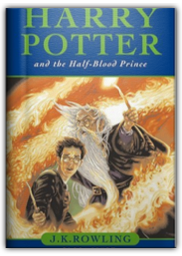
 Made with Delicious Library
Made with Delicious Library